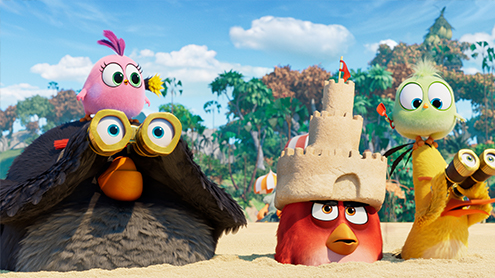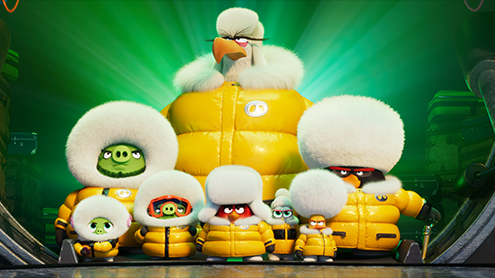INTERVIEW 2019
with Sony Pictures Imageworks’ Stirling Duguid
by Jessica Fernandes, Spark CG Society
August 29, 2019
Inside the FX of The Angry Birds Movie 2
The Angry Birds Movie 2 marks the return of our brightly feathered friends and their mischievous piggy foe, this time joining forces against a new threat — Zeta of Eagle Island. Stirling Duguid, VFX Supervisor at Sony Pictures Imageworks, sits down with us to chat about all things sequel, ice, snow, snot and FX.

How many people worked on this film, and what was the timeline?
We had 370 people working on it, over approximately two years.
Having worked on the previous Angry Birds movie, as well as this one, any notable differences between them?
The challenge of the first one was developing a game into a movie: establishing a connection to the original game that fans of it would be happy with. Whereas on this one, the filmmakers had more freedom. They didn’t have the same constraint (creating the world), instead they could jump off from what was already there. In addition, on The Angry Birds Movie 2, the main criteria for success from our director, and John Cohen, the producer, was how many laughs the shot got, and how loud were those laughs. That influenced every single decision that was made — is it funny? Or is it not?

Any curveballs in terms of planning?
To be honest, this was a very smooth project. Our client was outstanding. They storyboarded the whole movie, loved it, and they didn’t change much along the way. They also hit every turnover deadline for the sequences — that helped us have a steady flow of inventory to jump on. Our only real challenges were having some of our animators come on later than expected (due to finishing up on Spider-Man: Into the Spider-Verse), and lighting being compressed (when our release date moved up by three weeks).
For the last 11 weeks, we were finaling over a hundred shots a week, so yes, we were going at a pretty fast pace then. But I honestly don’t know if I’ll ever be on a project as smooth as this again. I’m grateful to have had this as my first VFX supervising experience. And hoping for likewise on the next one!
Was it plug-and-play with the assets you were re-using from the previous film? Or did they require substantial rework?
It sounds easy on paper: “Let’s just restore the characters from the old movie.” But in reality, from when we first started on the original movie, to the beginning of the sequel, 3.5 years had passed. In that time, technology had changed and we had progressed — hair grooming tools had improved and some of the shaders that we were using were different. Another major change was that our facility was moving to the ACES Color Space standard. Getting the colours of the characters to match with the first movie was actually quite a challenge, requiring us to go back and re-bake all of the textures with a new LUT, etc.
On the flip side, any time you get a second chance at something, you want to improve things. Once we started getting into the characters, we started remembering, “oh yeah, this was really hard on Red” — we should change that. So we evaluated if we had enough time for rigging to go back in and make things a little more modern, etc. If you have the time to spend up front in the development of the character, rigging, groom, etc. it definitely helps shot work down the line.

Was the goal to maintain continuity with the look of the previous movie? Or upgrade?
Because it was a sequel and we already had an established look, our goal was to match that look: if you did side-by-side turntables, the characters should look the same. We didn’t have that many new characters to create on this film, but we also had a smaller budget. As such, another goal was to maintain efficiency.
Something that really helped with efficiency was using Katana for our lighting pipeline. Over several years our development team had created tools to do sequence-based lighting, as opposed to shot lighting. These plugins enable a single lighting artist to light a sequence in its entirety, getting it 80-85% of the way to completion. This process worked out really well, allowing us to start key lighting right out of rough layout, which we hadn’t been able to do before. Even before animation had started, we were able to see all the shots in sequence, and a single artist could press a button and render all those frames right out of the box. It was great to get that jump start on things. When we looked at the numbers, our lighting times were less than half of that on the previous eight animated features that we’d worked on. It was a very, very, big savings!

What was the most complex or challenging sequence in Angry Birds 2?
The FX-heavy sequences were definitely the most challenging. One of the hardest effects was the beach break system with the ocean. Our FX supervisor, David Allen, took that on personally and began developing it right from the start of the show. He did an outstanding job — the waves and ocean look great, and that’s not easy to achieve.
The other one that stands-out to me is the creation of the ice-balls that fill with lava. The viz-dev team, led by Pete Oswald, our production designer, found an awesome YouTube video of someone in a very cold environment blowing bubbles. They were five-inch bubbles where you could see crystals form on the surface, before they froze solid. That was our inspiration and reference for how the bubbles would form. Next up, we needed to lock down what the ice crystals would look like, and then how we would fill them with lava, the viscosity of the lava, etc. It took quite a few iterations to get the look we were going for.
This movie also had a lot of one-off effects that had to be developed for just 1-2 shots. It’s a lot of work to make one-offs look good, and unfortunately you don’t get the benefit of amortizing that cost over a number of shots. Examples of this are some of the destruction shots (when the super-weapon explodes, the volcano collapses, the island implodes), the hatchling shots (on the beach, in the water, on the whale, in outer space), etc. Some of them have so many beautiful details, but they go by so quickly you might not see them on first viewing.
We also had snow, ice, footprints, sand, explosions, lava in different states (in the lamps, the fiery lava, the hardened lava, etc.). Lots of really amazing effects.

Speaking of the snow, it was beautiful. I love the way it crumbled under Red’s feet as he was trying to climb up a rock, what it looked like as they tunneled through it, etc. What can you tell us about that?
Thanks, I appreciate it, we spent a lot of time on it. We have done snow in the past, some of it a long time ago, on movies like The Polar Express and Arthur Christmas, but more recently we did Smallfoot, which came out last year. We had done quite a bit of snow development for it, and we were able to leverage a lot of that work.
Snow can be really challenging — sometimes it turns out too dry, sometimes too slushy. You have to find the right consistency, which requires experimentation and trial and error. Also, because the surface snow is geometry, and the kick snow is volume, each rendered with a different shader, getting both shaders to look and match seamlessly was an added feat. It sometimes came down to good comping to make sure the whites were matching and we had enough sparkle. It was a challenge, but the end product looked really cool.
There were also improvements made in terms of our sand dynamics on this show (as seen in the crab sequence, the chicks making sand angels, and at the very beginning of the film when Red, Bomb and Chuck pop out of the sand.)

In this movie there’s a whole new island made of ice, where Zeta lives. What can you tell us about it?
Zeta’s lair was actually one of the first new environments that we tackled. Initially, because it’s inside a volcano, it was meant to have dark rock walls. But the producer and director felt it was too dark and gloomy — they wanted it to be bright and friendly. We tried different lighting techniques, taking the roof off to give it a skylight feel, etc., but nothing was working. Ultimately, we decided to make the walls snow as opposed to rock, and add snow and ice throughout.
The look of ice is very dependent on the environment — what it’s reflecting or refracting. As such, there were a lot of choices to be made in terms of colours of the ice, how rough or smooth the surface is, and (due to all the refraction and reflection) how costly it was going to be. But things worked out well — I don’t remember what our average frame times were, but there was nothing sending up red flags.

Can you tell us anything about the animation?
Our director comes from an episodic TV background, and he’s a storyboard artist. He was over-the-moon working with our team. Every time he sent storyboards off to be animated, he gushed about how our animators, led by animation supervisor Pete Nash, were really plusing the ideas that he and his story team had come up with. The animators were outstanding — they did a great job!
Any special insights on the fake eagle suit the team puts on to infiltrate the lair?
The suit’s called Harvey. It’s its own character, rigged as per normal. But an interesting note is that there are scale cheats with it. When we actually put our team of heroes inside the suit for the interior shots, we found that we had to double the scale of the suit to make it work. Interior Harvey is 100% larger than exterior Harvey.
Here’s another interesting fact, the yellow snow suits that the team wears when they land on the new island, they’re actually rigged characters. We were trying to figure out how to make them more cost effective, and that solution helped us achieve it. Essentially, there are only two unique snow suits (Mighty Eagle’s, and the one all the other characters wear). Rigging the jackets was definitely a cost savings, and it looks great — the rig really sells the puffy jacket look. If it was simulated, it would droop more and would have wrinkles, but because it’s a puffy jacket it looks more accurate rigid.

I loved the detail with the parachute/map that rips. What can you tell us about that?
That was a combined effort: animation set the initial shapes, the CFX team put dynamics on it, and then FX took over and added the actual threads ripping. Similarly, with the Harvey suit, when Chuck starts peddling frantically and the suit rips in half — there was a lot of back-and-forth between departments to make that work.
And we can’t forget the pig-snot! So gross, but so effective. Any insights on that?
Lol, it took quite a few iterations to get that looking right, because there’s a distinction between the snot that’s on their body (in their feathers) and what’s on their extremities (connected to their fingertips). Our FX artist used two different techniques to achieve that, and was able to marry those two together quite seamlessly. And then of course, Bomb licks a drop of snot, which was pretty gross.
And he swims in a vat of it... while eating it. My gag reflex kicked in, but I was also mid-laugh!
The pig snot moment with Chuck and Bomb, that was in the original boards, but initially that whole sequence had a different ending. The bit where Bomb ends up swimming in the pig snot, that was actually a very late addition. Everyone loved the pig snot gag so much that they decided to end with Bomb swimming around in it.
What are you most proud of, or was most rewarding on this project?
I’m really proud of the quality level that we achieved and the relationships that we built on our team. For me, it’s important to make sure you have an environment that people want to work in. And I feel people do better work when they have that. We had a lot of fun making the film, and I think most people would agree. That was definitely my goal!
![]()
Thanks so much to Stirling for sharing his insights on The Angry Birds Movie 2. Summon your inner child and go check it out!
AB2 – © 2019 CTMG, Inc. All Rights Reserved.
 |
Jessica Fernandes is an adventurer and wordsmith based in Vancouver. She enjoys spreading appreciation for the arts through stories and encounters with inspiring creators. |
![]()
![]()
© 2024 · Spark CG Society


















